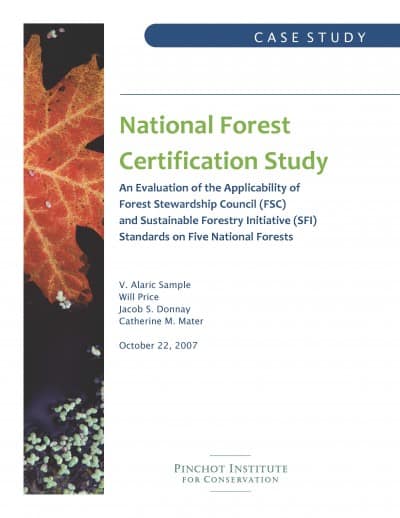Yesterday’s discussion was interesting, and I think we need to carry it forward. But my first thought was that I was proposing a solution to what many perceive to be a problem. It occurs to me that we may need to back up to understand how people think about whether there is a problem or not.
IF cutting trees and selling them can be done in a sustainable way (as environmental folks seem to think about FSC) (I know there is controversy about SFI vs. FSC, and I also don’t like the idea of public forests being managed to standards developed by third parties, still, the reason I brought it up is that it says that environmental groups think timber harvesting is OK in specific places, with specific practices).
I think it’s well worth a read of the Pinchot Institute’s National Forest Certification study Executive Summary here. If you have more time, you might be interested in the other documents.
This is from the Executive Summary of the Pinchot Institute study about forest certification:
This represented an important breakthrough in the contentious arena of forest conservation.
No longer were forest industry and environmental activists simply locked in a legal and policy stalemate over whether timber harvesting could take place, but how it could take place while ensuring that it is ecologically sound, economically viable, and socially responsible. These developments also held out the promise of calming some of the public controversy around forest management, by providing citizens with credible assurances that the forests in question were not being overexploited, and adequate protection was being provided for forest areas of exceptional importance for conservation values such as biodiversity, wildlife habitat or water quality
During the time period I was reviewing this study I always considered this to be MBWT “or management by wishful thinking”, but it is asserted in the study (also the Executive Summary):
This report describes the results of independent audits of five units of the National Forest System ranging from 500,000 to 1.5 million acres in size. This case study is the culmination of what has become a ten-year research project that ultimately involved forest certification audits on state forestlands in seven states, 30 areas of Native American tribal forestlands, and one national park. It should be noted that, in each case, the independent audits identified needs for corrective
actions, and in each case these were successfully addressed by the agencies’ forest managers. A general conclusion among the agencies themselves is that the reduction in costs associated with public controversy and legal challenges—not only on agency budgets but on the spirit and morale of their forest managers—more than offset the time and expense associated with the certification process.
(Italics mine)
So here were a couple of my concerns:
1) FSC practices are (were) all over the map. It would be better to certify to publicly developed practices (the equivalent of the broad labor union contract in conflict resolution?). But environmental groups are attached to FSC; we could have the public develop the practices and have third party audits, but then it wouldn’t be “FSC”. With all the technical and scientific folks in NFS and R&D and all the folks with practitioner knowledge, the State wildlife folks, etc. it just seems like you could do a better job with standards than FSC did.
2) It would be better for the FS to have a broader third party audits in terms of its management (beyond vegetation management, the whole enchilada, recreation, grazing, oil and gas, ski areas) (not so sure I still think that).
Now, some may think that everything is fine now. But I would ask everyone to “listen with the ears of the heart” as per Benedict of Nursia to a previous comment on this blog here by Rob DeHarport, where I think he articulated “the problem” clearly:
In my humble opinion the problem is two-fold. The first part is the utter failure of President Clinton’s Northwest Forest Plan (NWFP). Of the five stated priorities or goals in the NWFP, none have been fulfilled. Lawsuits and the potential of lawsuits on virtually every timber sale in the NW have resulted in the “Gordian Knot” that former USFS Chief Jack Ward Thomas has referred to in his assessment of the failed NWFP of which he was a key player. The state of Oregon, timber dependent counties, cities and schools continue to struggle to replace lost revenues that occurred soon after the Northwest Spotted Owl (NWSO) was listed as an endangered species.Neither the NWSO or local and state economies have been able to replace lost revenues despite the best efforts.
However, budgets have tightened, increased taxes are not likely in already poor counties. Curry County is virtually bankrupt. Lane County can not afford to hold violent criminals in jail, etc. etc. Meanwhile, the Federal government Rural School Funds have dried up as the nation continues to print and borrow money at a record and unsustainable pace. The NWFP was supposed to find a “middle ground,” it did not happen. Yet, here we are nearly 20 years later living with a failed plan. Governor Kitzhaber created another committee of stake-holders to find a solution with little or no success.
Mac McConnell’s statement is true. In US House District 4 there are nearly 5 million acres of National Forest. Since the NWFP logging has been scaled back far below what the NWFP called for due to continued protests. The logging that is occurring on these lands will essentially create a 5 million acre spotted owl reserve. As the thinning projects leave trees that are less than 80 years old to grow to age 80 and older- thus becoming “Old Growth Spotted Owl Habitat.”
I live in the Oakridge area of the Willamette National Forest, I have walked with USFS staff through a couple of thinning timber sales as I mentioned in the previous paragraph. These sales take years of planning and navigation through the “Gordian Knot.” There is also the excellent Jim’s Creek Oak Savanna Restoration Project near my home that has been stymied at a little more than 400 acres due to the very real risk of litigation or the lack of commitment by USFS upper management to allow such good sound forestry.
Here are two paragraphs from Wikipedia concerning the Elliott State Forest:
Controversy arose in 2011 in response to changes in the way the forest is managed. Adopted by the land board in October 2011, a new management plan aims to increase annual net revenue from the forest to $13 million, up from $8 million. It would achieve this by increasing the annual timber harvest to 40 million board feet culled from 1,100 acres (450 ha), of which about three-fourths could be clearcut. The former management plan, adopted in 1995, called for 25 million board feet from 1,000 acres (400 ha), half of it clearcut.[5]The plan also changed the way in which the forest is managed to protect threatened and endangered species such as spotted owls, marbled murrelets, and Coho salmon. Supporters of the new plan say it will benefit wildlife by making more acres off-limits to logging than had been reserved for owls, murrelets, and watershed protection under the old plan. Opponents of the plan say it will damage habitat and harm wildlife. They would prefer a plan that promotes thinning of young trees, avoids clear-cutting, and seeks other ways of raising revenue from the CSF lands.[5]
In July 2012 despite the great recession the US imported $216 million dollars of softwood lumber from Canada. (according to the Sept. 17, Globe and Mail) Meanwhile rural Oregon timber counties have a unemployment rate that is actually over 20%, and our forest continue to be passively managed at best.
I am the Mayor of the small community of Westfir and serve on the Oakridge, Oregon School Board. I know first hand how failed policy has impacted rural Oregon timber towns and counties. There is a middle ground, we have not come close to finding that sweet spot in managing our forests.
I’d be interested in hearing
If you don’t think that there is a problem, and why..
What you think about whether certification alone would solve “the problem” in your opinion.
Apparently some in the environmental community doesn’t want NFS to do certification, I’d be interested in their rationale, if anyone knows.








